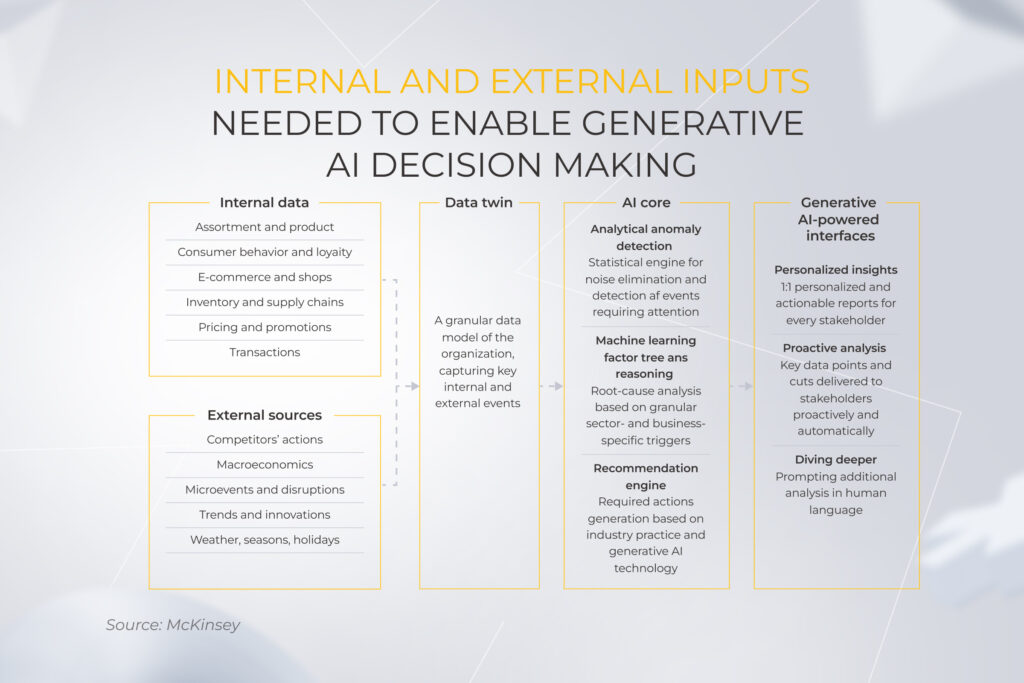Updated: April 23, 2025
Contents
Key highlights
- From customized product visualizations to conversational chatbots and at-scale content generation, generative AI in ecommerce has become a fixture.
- Adopting AI solutions for ecommerce takes dedicated effort, scale-ready tech infrastructure, and a careful selection of training and deployment methods to keep sensitive data secure.
- The path from LLM to ROI lies through specific use cases and point gen AI solutions that can later be scaled to fit broader business needs and functions.
Retail leaders act like pioneers, diving headfirst into cutting-edge technologies and innovative sales channels to satisfy discerning customers. Generative AI in ecommerce has quickly proved to be yet another powerful and cost-effective tool for them to woo loyal buyers, impress would-be customers, and master the three Rs of top-grade ecommerce — serving the right offer at the right time for the right person.
But despite its no-regret efficiency gains and broad appeal, machine learning and generative AI require careful navigation. There are still risks to consider, tech capabilities to embrace, and ethical considerations to take heed of.
So here we are, exploring the concept of AI in ecommerce, breaking down the latest proven use cases of gen AI in ecommerce, sharing the secrets of how to boost revenue growth with generative AI, and outlining an implementation roadmap for faster gen AI wins.
What is generative AI in ecommerce?
Where traditional AI finds insights in data, Generative AI acts on them, producing tailored marketing content from product descriptions and ad creatives to email campaigns and landing pages. It also aids in creating personalized product suggestions, real-time chat replies, and even new virtual experiences.
Benefits of adopting generative AI for your ecommerce business
For ecommerce high-performers (those growing at least 10% faster than the industry average) generative AI has become the number one priority. In fact, over a third plan to allocate up to 25% of their budgets toward incorporating generative AI across business operations by the end of 2025. The rationale behind this stems from tangible perks companies anticipate.
Higher customer satisfaction
Typically, retailers cover only three of the seven steps of the customer journey, leaving the rest of customer interactions unattended. Ecommerce AI solutions can pick up the slack by turning unstructured data into clear insights about what consumer expectations really are across the entire value chain. With these insights, brands can deliver personalized customer experiences from initial product discovery to after-sales support, helping shoppers:
- find what they want faster with tailored product suggestions or detailed, adaptive descriptions based on their queries
- easily compare options and choose the best fit thanks to review summarizations and feature-based comparisons
- secure better deals as gen AI tools can adjust pricing on the fly based on competitor pricing and customer behavior data
- resolve issues more efficiently or get on-point clarifications 24/7 with context-aware AI-powered chat assistance
Faster, error-free operations
Ecommerce businesses can also implement generative AI solutions to automate time-consuming routine tasks such as product data entry, sales reporting, customer assistance, and others. Not only do gen AI tools speed these tasks up, but they also complete them with near 100% precision.
Besides, with drudgery handed off to generative AI algorithms, companies unlock cost savings and shift their focus to perfecting marketing strategies, adding innovative product features, and other profit-driving areas that hinge on the creative process.
Better efficiency
Another reason why businesses are rushing to employ generative AI is its potential to deliver both short- and long-term efficiency gains.
From delivery route planning and inventory management to the generation of product visuals at scale, gen AI-powered tasks execution brings substantial impact with fewer resources.
Before gen AI, running targeted marketing campaigns, for instance, required a full team and weeks of preparation. Now, a single FTE armed with a custom pre-trained generative transformer can ideate and launch a campaign in a day. Whether it’s creating unique concepts, running A/B tests, selecting optimal timing, or refining targeting strategies, generative AI tools handle every task, ensuring conversion rates are maximized.
— Chad West, Managing Director USA, *instinctools
Sharper decision making
Retailers often race against the clock, trying to analyze what caused sales dips, what market trends to gear up for, and what specific smart moves their competitors made to hit it big with their last marketing campaign. And not all of this data is easy and fast to measure and monitor.
Paired with a robust AI core and a comprehensive data engine, generative AI can deliver whatever insights your ecommerce company needs at the moment and do it in a straightforward, conversational, and actionable way.
Many faces of generative AI in ecommerce
According to Precedence Research, the generative AI for ecommerce is expected to grow by over 320% by 2034. The growth this rapid owes much to its cross-modal versatility.
Gen AI content can be delivered in text, images, videos, audio, and even 3D representations. Below, we’ve broken down specific use cases each representation targets in ecommerce.
| Modality | Application | Use case |
| Text | Content production | – Product descriptions – Personalized AI ecommerce marketing – Messaging and notifications |
| Chatbots | – Ecommerce customer service tasks and support – Personalized online shopping journey | |
| Search | – Personalized product search – Product recommendations | |
| Analysis | – Supply chain and inventory management – Fraud detection – Sentiment analysis – Social listening – Customer and market analysis – New product analysis | |
| Image | Image generator | – Product images and ads generation |
| Audio | Voicebots | – Voice search – Voice-based product recommendations – Voice-activated shopping carts – Soundtrack generation for marketing purposes |
| Video | Video creation | – Video generation for marketing purposes – Video product description – Product tutorials and manuals |
| 3D representation | Product representation | – 3D product catalogs – Virtual fashion design – New product design |
| Product design | – Turning text descriptions into 3D product models |
Although multi-functional, a gen AI model’s application layer fine-tunes it to complete a specific task.
11 generative AI use cases in ecommerce
Retailers juggle too much to boost margins and keep customers happy — inventory glut, fragile supply chains, ever-increasing number of distribution channels. But now, generative AI systems take the complexity and tedium off their plate.
1. Personalized product visualization
Hyper-personalization is the new status quo for the ecommerce industry, with the majority of customers favoring a curated shopping experience in online stores. Generative AI lives up to the demand and allows customers to customize and play with the styles, colors, and fabrics of the products.
- Stitch Fix, an online personal styling service, uses its Outfit Creation Model (OCM) to compile and visualize personalized outfit suggestions based on a consumer’s previous purchases, customer preferences, size, budget, and style.
Sephora and Ulta Beauty are using generative AI to develop personalized skincare product recommendations.

2. Virtual try-ons
Around 19% of US beauty consumers say that virtual product try-ons would help them feel more confident purchasing products digitally. Generative AI brings the visual try-on experience to each screen, allowing consumers to create realistic representations of clothes and other products.
Unlike traditional virtual try-on tools, generative AI applications make the fitting experience more mindful of a body shape, skin tone, and personal style.
- Google constantly enhances its virtual try-on feature that demonstrates how clothes look on real models with different hair types, body types, skin types, ethnicities, and sizes.
- Ulta Beauty uses style transfer technique, another gen AI offshoot allowing the customer to take two images — a self-portrait and a style reference image — and blend them together to offer a virtual hair style and colour try-on experience.

3. Human-like chatbots
Traditional ecommerce chatbots and virtual assistants guide customers through basic linear flows but have a hard time thinking outside the predefined boundaries. With generative AI chatbots, it’s all different. Retailers swap generic responses for human-like interactions and provide accurate 24/7 support to users, boosting customer service efficiency.
Generative AI can also supplement chatbots with natural language processing capabilities, enabling the bots to process natural language inputs (voice or text) and serve up empathetic outputs for after-sales support and issue resolution.
4. Product discovery and search personalization
In product discovery, generative AI can analyze customer preferences, behavior, and past purchase history to offer personalized product suggestions. Helping customers find relevant new products led to higher spend in 69% of instances.
On the same line, gen AI tools reduce search time as they can anticipate user preferences and search intent.

Besides, with more intuitive, conversational search, discovering products gets easier. Instead of browsing hundreds of product names, customers can describe what they are looking for in their own words, and the virtual assistant will make recommendations. Generative AI powered tools can also interpret uploaded images and process short videos.
5. Content generation assistant
Creating accurate product content for thousands of SKUs is not for the faint-hearted. That’s why AI-generated content was among the first use cases that picked up steam in ecommerce. Gen AI powered solutions have simplified content production for product descriptions, listings, tailored marketing messages, and even social media posts.
- Amazon was among the first to bridge AI content and ecommerce, helping sellers write product descriptions at scale.
- Heinz uses generative AI to create images for advertising.
- Shoplazza, an ecommerce website builder, has implemented gen AI models to transform mannequin models into real models.

Whatever it is, AI development services reduce the cost of content creation and streamline manual tasks.
6. Market research
When testing the waters of new markets and customer cohorts, ecommerce businesses need to comb through vast amounts of data to inform their strategies. Customer feedback on social media platforms, extensive customer data, competitors’ ecommerce companies’ moves, and other valuable data have to be made sense of.
Here’s how generative AI can help with analysis-related tasks in ecommerce:
- Market intelligence — gen AI can help simulate market scenarios, produce synthetic data to fill data gaps, and forecast customer responses based on historical data.
- Information summarization — instead of spending months on research, ecommerce brands can employ AI tools to read and analyze existing material.
- Novel market and customer segmentation or product opportunities — gen AI algorithms can uncover untapped market and customer segments as well as identify new product niches within the target market.
7. Planning for promotions and marketing campaigns
Generative AI can supercharge sales and marketing campaigns with personalized loyalty programs and discount structures. Smart generative AI algorithms analyze customer data to create tailored rewards and incentives.
Additionally, gen AI tools can extract valuable insights from EPoS and transactional data using predictive analytics, informing promotional efforts, pricing strategies, and production processes based on expected demand.
8. Boosting retail media networks
Retail media networks rely on loyalty and transaction data to sell ad inventory to third-party brands. By analyzing and deriving insights from customer data, gen AI tools can tell ecommerce businesses what advertiser categories to draw to their RMNs.
Within the network, generative AI tools can help advertisers tie together and optimize their ad spend. Generative artificial intelligence can also
- analyze the best-performing offerings of advertisers,
- match them to relevant consumers,
- and generate campaign configurations to replicate ad success.
It’s a win-win for both: advertisers get the bang for the buck, while retailers get to generate more RMN revenue.
9. Supply chain and inventory management
Out of all industries, retail supply chains are the most dynamic due to ever-evolving customer demand, a large number of products, and rapid product life cycles. Generative AI adds simplicity to supply chain management by taking over the analytics inherent in the process.
AI ecommerce startups today offer many Gen AI tools that can analyze historical and real-time sales data to predict demand, calculate safety stock levels, and identify slow-moving stock. These tools can also assist gen AI ecommerce businesses in:
- Running what-if scenarios to get prepared for supply chain disruptions and fluctuations in demand
- Evaluating suppliers by analyzing financial reports, performance metrics, and other data
- Optimizing logistics routes by analyzing warehouse locations, transport links, and demand patterns
- Improving last-mile delivery by selecting the right delivery or pickup routes based on traffic conditions, weather, and other data.
10. Gen AI-driven pricing
Generative AI models support AI-driven tools in identifying the optimal path to a retailer’s sustainable financial health. To do that, AI tools perform price simulations where they create various market scenarios based on: historical data, competitors’ behavior, market trends, etc.
Price simulations also allow ecommerce businesses to locate key-value categories and items in their portfolio, refine their pricing strategy, and spot implicit cross-dependencies between products.
Moreover, with demand-based pricing, ecommerce owners can model demand curves based on seasonality, inflation rates, income levels, and other variables to optimize pricing during spikes or slowdowns in demand.
11. Fraud detection
Generative AI and ecommerce make a powerful combo when it comes to anomaly detection. Traditional methods don’t catch fast-changing fraud tactics. Conversely, generative AI stays adaptive to new fraud patterns by constantly vacuuming up consumer data and analyzing it with past customer interactions.
By understanding genuine past customer behavior and previously detected fraud patterns, generative AI can simulate fraudulent activities and train AI algorithms to detect and counteract them. Paired with a conversational interface, generative AI can also notify fraud engineers about risk flow and give reliable recommendations on what to do next.
Don’t miss a chance to uncover new opportunities with gen AI
Leveraging generative AI for ecommerce takes dedicated effort
The promise of generative AI is enticing. But it can only deliver on its promise if implemented with your unique business strategy, needs, and constraints accounted for.
Get ready for generative AI transformation
A convincing, measurable business case is the foundation for any AI-based adoption. It should define:
- a specific business challenge
- the outcomes to measure gen AI implementation’s effectiveness
Without a business case outlined, you won’t get a clear understanding of the data needed to train the model and the technical expertise required to set the AI infrastructure in place.
Choose the right model
The choice of a foundational model and the technologies powering it depends on:
- your use case,
- the type and quality of your data,
- and the limitations of your infrastructure.
You might consider implementing Generative Adversarial Networks (GANs) models for image generation, while models like GPT are more suitable for text-only applications.
Gen AI tools aren’t automatically compliant with industry rules, so choose the right training and deployment method to keep customer and sales data safe.
Train, evaluate, and fine-tune the model
The training process begins after collecting and preprocessing data. A lot of back-and-forth identifies the optimal model architecture, hyperparameters, and training algorithm to achieve stable and safe performance. Once the model is trained, you should consistently evaluate its performance and fine-tune the model based on periodic test results.
Deploy and monitor
When the model is up and running, it’s time to make it a part of your ecommerce architecture.
Based on your objectives, you may need to deploy it to a cloud-based service, create a dedicated user interface, or integrate the documents and knowledge databases of your ecommerce business with the model. Once the model is deployed, it needs regular performance monitoring to make sure it lives up to expectations.
Maintain and improve
AI-based models are only as good as the data powering them. Therefore, make sure to refine data patterns to prevent model drifting and update the model as and when necessary. In some cases, your model may need retraining, in other times, new monitoring processes may keep your model up to date. As your ecommerce business grows, be sure to scale the model accordingly.
Keep in mind that AI adoption success goes beyond the pilot. You need to embrace a mature and calibrated practice supported by tailored tactics and hands-on advice from an experienced vendor.
Challenges to clear before gen AI implementation
To see value from generative AI solutions, ecommerce businesses have to take heed of the following considerations.
Data quality and bias
Your gen AI application is only as good as your data. To work effectively, it requires a rich palette of internal and external data that’s accurate, diverse, and representative of real-world scenarios and customer queries.

If any of these boxes are left unchecked, your generative AI solution can perpetuate biases and churn out irrelevant outputs, hurting customer engagement and harming your bottom line.
Scale-ready adoption environment
You may already have a tech estate ready for gen AI adoption, but unless it’s scalable, you will end up with costly gen AI replications that will also be hard to upsize. The optimal gen AI architecture for retailers is function-agnostic and market-agnostic, meaning it can augment various business functions across different markets.
Techwise, an agile generative AI architecture requires the implementation of modular components that will allow for easy LLM swapping and scaling.
Data security and ethical considerations
As generative AI applications thrive on customer data, you must make sure they do it in a secure and responsible way. This includes adherence to relevant data privacy regulations such as GDPR, CCPA, PCI DSS, CalFIPA, and others.
Along with regulation-induced security measures, your gen AI applications must also have data encryption at rest and in transit, role-based access controls, network security, and other data security safeguards if you want your gen AI solutions to be ethically sound and good at maintaining customer trust.
Wrapping up
When powered with AI, an ecommerce business model is more efficient, customer-centric, and future-ready. AI can increase ecommerce sales, deliver unparalleled customer experiences, and more. Instead of getting carried away with the persuasive abilities of AI technologies, retailers should rely on a specific business case to spearhead their gen AI journey focused on fostering customer loyalty.
The right choice of a generative AI model, infrastructure readiness, and dedicated human expertise cracks the code of adoption and makes generative AI a low-risk investment for ecommerce businesses and commerce media professionals.
Let’s begin your gen AI journey together
FAQ
According to Precedence Research, the global artificial intelligence in ecommerce market size is expected to achieve $22.60 billion by 2032. We can assume that the ecommerce and AI duo will gain even more traction, ushering in new, competitive capabilities.
In ecommerce, generative AI has taken over a lot of repetitive tasks, including customer support, product descriptions, and ad generation. The technology also assists retailers in forecasting demand, maintaining optimal inventory levels, and providing novel shopping experiences.
Artificial intelligence elevates the customer experience, improves the accuracy of sales forecasts, amplifies marketing with personalized messaging, automates follow-up abandoned cart inquiries, and more.
Artificial intelligence improves lead retargeting, enhances customer experience, optimizes dynamic pricing strategies, and enables hyper-personalization in marketing. This increases conversion, leading to more sales.
Before adopting AI models, retailers need to make sure models are compliant with applicable regulations and have enough training data to prevent model bias.










